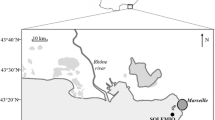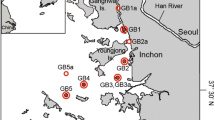Abstract
The effects of inorganic nutrient (N and P) and glucose C treatments on bacterial growth were followed for 3 days in natural surface and deep water bacterial samples during the main post-spring bloom stages of phytoplankton growth in the northern Baltic Sea. In addition, the importance of photochemical degradation of dissolved organic matter on bacterial growth was investigated vertically (0.1–2.0 m) and spatially, in a salinity gradient from river mouth to open sea. Bacterial production was consistently C limited in the surface layer, with N or both N and P as the secondary limiting nutrients from spring to early summer and in late summer, respectively. In deep water, bacterial growth showed combined temperature and C limitation, and in spring, this also appeared to be true with surface samples. The effect of 1-day sunlight pre-treatment varied from no effect up to a 44% production increase, with clear bacterial production responses only being seen at the surface (10 cm depth). The implications of bacterial C limitation for the structure and function of the surface plankton ecosystem, including its CO2 exchange with the atmosphere are discussed.




Similar content being viewed by others
References
Ameryk, A., B. Podgórska, and Z. Witek. 2005. The dependence between bacterial production and environmental conditions in the Gulf of Gdańsk. Oceanologia 47: 27–45.
Autio, R. 1992. Temperature regulation of brackish water bacterioplankton. Archiv für Hydrobiologie Beiheft Ergebnisse der Limnologie 37: 253–263.
Autio, R. 1998. Response of a seasonally cold-water bacterioplankton to temperature and substrate treatments. Estuarine, Coastal and Shelf Science 46: 465–474.
Babin, M., D. Stramski, G.M. Ferrari, H. Claustre, A. Bricaud, G. Obolensky, and N. Hoepffner. 2003. Variations in the light absorption coefficients of phytoplankton, nonalgal particles, and dissolved organic matter in coastal waters around Europe. Journal of Geophysical Research 108(C7): 3211–3230.
Benner, R., and B. Biddanda. 1998. Photochemical transformations of surface and deep marine dissolved organic matter: Effects on bacterial growth. Limnology and Oceanography 43: 1373–1378.
Børsheim, K.Y., and G. Bratbak. 1987. Cell volume to cell carbon conversion factors for a bacterivorous Monas sp Enriched from seawater. Marine Ecology. Progress Series 36: 171–175.
Carlson, C.A., H.W. Ducklow, and A.F. Michaelis. 1994. Annual flux of dissolved organic carbon from the euphotic zone in the northwestern Sargasso Sea. Nature 371: 405–408.
Cotner, J.B., J.W. Ammerman, E.R. Peele, and E. Bentzen. 1997. Phosphorus-limited bacterioplankton growth in the Sargasso Sea. Aquatic Microbial Ecology 13: 141–149.
Elser, J., L.B. Stabler, and R.P. Hasset. 1995. Nutrient limitation of bacterial growth and rates of bacterivory in lakes and oceans: a comparative study. Aquatic Microbial Ecology 9: 105–110.
Emerson, S., P. Quay, C. Winn, L. Tupas, and M. Landry. 1997. Experimental determination of the organic carbon flux from open-ocean surface waters. Nature 389: 951–954.
Engbrodt, R., and G. Kattner. 2005. On the biogeochemistry of dissolved carbohydrates in the Greenland Sea (Arctic). Organic Geochemistry 36: 937–948.
Grasshoff, K. 1976. Methods of seawater analysis. Weinheim: Verlag Chemie.
Guzmán, M.I., M.R. Hoffmann, and A.J. Colussi. 2007. Photolysis of pyruvic acid in ice: Possible relevance to CO and CO2 ice core record anomalies. Journal of Geophysical Research 112: D10123.
Haas, L.W. 1982. Improved epifluorescence microscopy for observing planktonic microorganisms. Annales de l’Institut oceÂanographique Paris 58: 261–266.
Hobbie, J.E., R.J. Daley, and S. Jasper. 1977. Use of nucleopore filters for counting bacteria by fluorescence microscopy. Applied and Environmental Microbiology 33: 1225–1228.
Hu, C., F.E. Muller-Karger, and R.G. Zepp. 2002. Absorbance, absorption coefficient, and apparent quantum yield: A comment on common ambiguity in the use of these optical concepts. Limnology and Oceanography 47: 1261–1267.
Jespersen, A.-M., and K. Christoffersen. 1987. Measurements of chlorophyll-a from phytoplankton using ethanol as extraction solvent. Archiv für Hydrobiologie 109: 445–454.
Jørgensen, N.O.G., L.J. Tranvik, and G. Mine Berg. 1999. Occurence and bacterial cycling of dissolved nitrogen in the Gulf of Riga, the Baltic Sea. Marine Ecology Progress Series 191: 1–18.
Kirchman, D.L., and J.H. Rich. 1997. Regulation of bacterial growth rates by dissolved organic carbon and temperature in the Equatorial Pacific Ocean. Microbial Ecology 33: 22–30.
Kirchman, D.L., R.R. Malmstrom, and M.T. Cottrell. 2005. Control of bacterial growth by temperature and organic matter in the western Arctic. Deep-Sea Research II 52: 3386–3395.
Kivi, K., S. Kaitala, H. Kuosa, J. Kuparinen, E. Leskinen, R. Lignell, B. Marcussen, and T. Tamminen. 1993. Nutrient limitation and grazing control of the Baltic plankton community during annual succession. Limnology and Oceanography 38: 893–905.
Koopmans, D.J., and D.A. Bronk. 2002. Photochemical production of dissolved inorganic nitrogen and primary amines from dissolved organic nitrogen in waters of two estuaries and adjacent surficial groundwaters. Aquatic Microbial Ecology 26: 295–304.
Kuparinen, J., and A. Heinänen. 1993. Inorganic Nutrient and Carbon Controlled Bacterioplankton Growth in the Baltic Sea. Estuarine, Coastal and Shelf Science 37: 271–285.
Laanemets, J., K. Kononen, J. Pavelson, and E.-L. Poutanen. 2004. Vertical location of seasonal nutriclines in the western Gulf of Finland. Journal of Marine Systems 52: 1–13.
Lignell, R. 1990. Excretion of organic carbon by phytoplankton: its relation to algal biomass, primary productivity and bacterial secondary productivity in the Baltic Sea. Marine Ecology Progress Series 68: 85–99.
Lignell, R., S. Kaitala, and H. Kuosa. 1992. Factors controlling phyto- and bacterioplankton in late spring on a salinity gradient in the northern Baltic. Marine Ecology Progress Series 86: 273–281.
Lignell, R., J. Seppälä, P. Kuuppo, T. Tamminen, T. Andersen, and I. Gismervik. 2003. Beyond bulk properties: Responses of coastal summer plankton communities to nutrient enrichment in the northern Baltic Sea. Limnology and Oceanography 48: 189–209.
Lignell, R., L. Hoikkala, and T. Lahtinen. 2008. Effects of inorganic nutrients, glucose and solar radiation treatments on bacterial growth and exploitation of dissolved organic carbon and nitrogen in the northern Baltic Sea. Aquatic Microbial Ecology 51: 209–221.
Massana, R., J.M. Gasol, P.K. Bjørnsen, M. Blackburn, Å. Hagström, S. Hietanen, B.H. Hygum, J. Kuparinen, and C. Pedrós-Alió. 1997. Measurement of bacterial size via image analysis of epifluorescence preparations: Description of an inexpensive system and solutions to some of the most common problems. Scientia Marina 61: 397–407.
Moran, M.A., and R.G. Zepp. 1997. Role of Photoreactions in the formation of biologically labile compounds from dissolved organic matter. Limnology and Oceanography 42: 1307–1316.
Myklestad, S.M., and K.Y. Børsheim. 2007. Dynamics of carbohydrates in the Norwegian Sea inferred from monthly profiles collected during 3 years at 66°N, 2°E. Marine Chemistry 107: 475–485.
Myklestad, S.M., E. Skånøy, and S. Hestmann. 1997. A sensitive and rapid method for analysis of dissolved mono- and polysaccharides in seawater. Marine Chemistry 56: 279–286.
Nausch, M., and E. Kerstan. 2003. The relationship between dissolved carbohydrates and carbohydrate-degrading enzymes in the salinity gradient of the Pomeranian bight (southern Baltic). Oceanologia 45: 437–452.
Niemi, Å. 1975. Ecology of phytoplankton in the Tvärminne area, SW coast of Finland. II. Primary production and environmental conditions in the archipelago and the sea zone. Acta Botanica Fennica 105: 1–73.
Norland, S. 1993. The relationship between biomass and volume of bacteria. Handbook of Methods in Aquatic Microbial Ecology. Boca Raton: Lewis.
Obernosterer, I., R. Sempéré, and G.J. Herndl. 2001. Ultraviolet radiation induces reversal of the bioavailability of DOM to marine bacterioplankton. Aquatic Microbial Ecology 24: 61–68.
Pakulski, J.D., and R. Benner. 1994. Abundance and distribution of carbohydrates in the ocean. Limnology and Oceanography 39: 930–940.
Pinhassi, J., L. Gómez-Consarnau, L. Alonso-Sáez, M.M. Sala, M. Vidal, C. Pedrós-Alió, and J.M. Gasol. 2006. Seasonal changes in bacterioplankton nutrient limitation and their effects on bacterial community composition in the NW Mediterranean Sea. Aquatic Microbial Ecology 44: 241–252.
Pomeroy, L.R., and W.J. Wiebe. 2001. Temperature and substrates as interactive limiting factors for marine heterotrophic bacteria. Aquatic Microbial Ecology 23: 187–204.
Rich, J.H., H.W. Ducklow, and D.L. Kirchman. 1996. Concentrations and uptake of neutral monosaccharides along 140ºW in the equatorial Pacific: Contribution of glucose to heterotrophic bacterial activity and the DOM flux. Limnology and Oceanography 41: 595–604.
Riemann, B., P.K. Bjørnsen, S. Newell, and R. Fallon. 1987. Calculation of cell production of coastal marine bacteria based on measured incorporation of [3H]thymidine. Limnology and Oceanography 32: 471–476.
Rivkin, R.B., and M.R. Anderson. 1997. Inorganic nutrient limitation of oceanic bacterioplankton. Limnology and Oceanography 42: 730–740.
Sala, M.M., F. Peters, J.M. Gasol, C. Pedrós-Alió, C. Marrasé, and D. Vaqué. 2002. Seasonal and spatial variations in the nutrient limitation of bacterioplankton growth in the northwestern Mediterranean. Aquatic Microbial Ecology 27: 47–56.
Siegenthaler, U., and J.L. Sarmiento. 1993. Atmospheric carbon dioxide and the ocean. Nature 365: 119–125.
Skoog, A., B. Biddanda, and R. Benner. 1999. Bacterial utilization of dissolved glucose in the upper water column of the Gulf of Mexico. Limnology and Oceanography 44: 1625–1633.
Smith, E.M., and R. Benner. 2005. Photochemical transformations of riverine dissolved organic matter: effects on estuarine bacterial metabolism and nutrient demand. Aquatic Microbial Ecology 40: 37–50.
Søndergaard, M., P.J.le B. Williams, G. Cauwet, B. Riemann, C. Robinson, S. Terzic, E.M.S. Woodward, and J. Worm. 2000. Net accumulation and flux of dissolved organic carbon and dissolved organic nitrogen in marine planktonic communities. Limnology and Oceanography 45: 1097–1111.
Thingstad, T.F., and R. Lignell. 1997. Theoretical models for the control of bacterial growth rate, abundance, diversity and carbon demand. Aquatic Microbial Ecology 13: 19–27.
Thingstad, T.F., E.F. Skjoldal, and R.A. Bohne. 1993. Phosphorus cycling and algal–bacterial competition in Sandsfjord, western Norway. Marine Ecology Progress Series 99: 239–259.
Thingstad, T.F., Å. Hagström, and F. Rassoulzadegan. 1997. Accumulation of degradable DOC in surface waters: Is it caused by a malfunctioning microbial loop? Limnology and Oceanography 42(2): 398–404.
Thingstad, T.F., U.L. Zweifel, and F. Rassoulzadegan. 1998. P limitation of heterotrophic bacteria and phytoplankton in the northwest Mediterranean. Limnology and Oceanography 43: 88–94.
Thingstad, T.F., H. Havskum, H. Kaas, T.G. Nielsen, B. Riemann, D. Lefevre, and P.J.le B. Williams. 1999. Bacteria–protist interactions and organic matter degradation under P-limited conditions: Analysis of an enclosure experiment using a simple model. Limnology and Oceanography 44: 62–79.
Thingstad, T.F., H. Havskum, U.L. Zweifel, E. Berdalet, M.M. Sala, F. Peters, M. Alcaraz, R. Scharek, M. Perez, S. Jacquet, G.A.F. Flaten, J.R. Dolan, C. Marrasé, F. Rassoulzadegan, Å. Hagstrøm, and D. Vaulot. 2007. Ability of a “minimum” microbial food web model to reproduce response patterns observed in mesocosms manipulated with N and P, glucose, and Si. Journal of Marine Systems 64: 15–34.
Thingstad, T.F., R.G.J. Bellerby, G. Bratbak, K.Y. Borsheim, J.K. Egge, M. Heldal, A. Larsen, C. Neill, J. Nejstgaard, S. Norland, R.A. Sandaa, E.F. Skjoldal, T. Tanaka, R. Thyrhaug, and B. Topper. 2008. Counterintuitive carbon-to-nutrient coupling in an Arctic pelagic ecosystem. Nature 455(7211): 387–390.
Utermöhl, H. 1958. Zur Vervollkommung der quantitativen Phytoplanktonmethodik. Mitteilungen der International Vereinigung fur Theoretische and Angewandte Limnologie 9: 1–38.
Vähätalo, A.V., and R.G. Zepp. 2005. Photochemical mineralization of dissolved organic nitrogen to ammonium in the Baltic sea. Environmental Science and Technology 39: 6985–6992.
Vähätalo, A., K. Salonen, U. Münster, M. Järvinen, and R.G. Wetzel. 2003. Photochemical transformation of allochtonous organic matter provides bioavailable nutrients in a humic lake. Archiv für Hydrobiologie 156: 287–314.
Williams, P.J.le B. 1995. Evidence for the seasonal accumulation of carbon-rich dissolved organic material, its scale in comparison with changes in particulate material and the consequential effect on net C/N assimilation ratios. Marine Chemistry 51: 17–29.
Zweifel, U.L. 1999. Factors controlling accumulation of labile dissolved organic carbon in the Gulf of Riga. Estuarine, Coastal and Shelf Science 48: 357–370.
Zweifel, U.L., B. Norrman, and Å. Hagström. 1993. Consumption of dissolved organic carbon by marine bacteria and demands for inorganic nutrients. Marine Ecology Progress Series 101: 23–32.
Acknowledgements
K. Kivi is acknowledged for counting phyto- and zooplankton samples. V. Norros and the Tvärminne staff, especially E. Salminen, M. Sjöblom and T. Sjölund, are thanked for their valuable contribution during sampling and laboratory work. This investigation was funded by the Walter and Andrée de Nottbeck Foundation, the Academy of Finland and EU project DANLIM (EVK3-2001-00049).
Author information
Authors and Affiliations
Corresponding author
Rights and permissions
About this article
Cite this article
Hoikkala, L., Aarnos, H. & Lignell, R. Changes in Nutrient and Carbon Availability and Temperature as Factors Controlling Bacterial Growth in the Northern Baltic Sea. Estuaries and Coasts 32, 720–733 (2009). https://doi.org/10.1007/s12237-009-9154-z
Received:
Revised:
Accepted:
Published:
Issue Date:
DOI: https://doi.org/10.1007/s12237-009-9154-z




